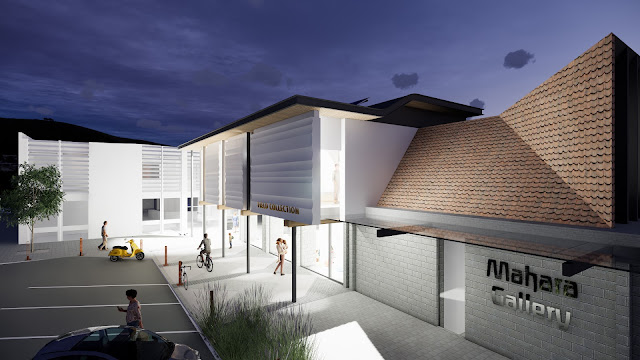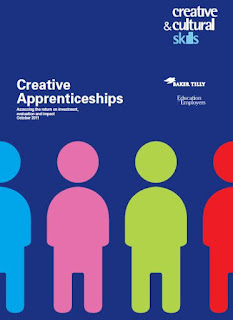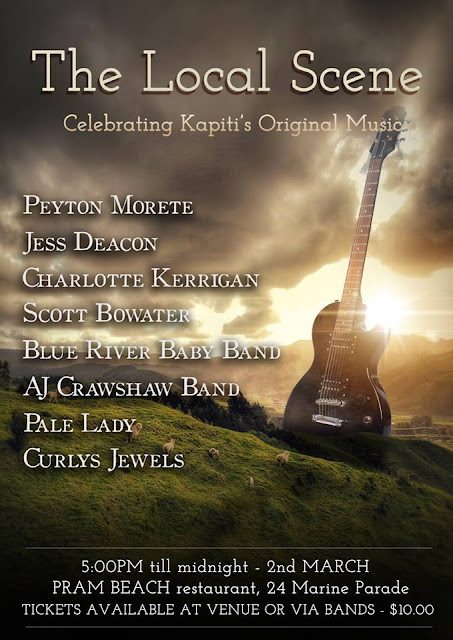More than 38 artists in latest Mahara Gallery exhibition
People are continuing to create during the Covid-19 cristis and that is not only a huge comfort to the wider population, but downright inspirational. Psychologists have noted that creativity increases during a crisis, as the usual psychological barriers that stop people from being creative, fade into the background. The act of creativity is thought to be a defence against feeling helpless. Creativity is also the glue that binds us together, as Mahara Gallery director, Janet Bayly, knows only too well. I caught up with Janet the old fashioned way - by telephone, as well as online, to catch up on Mahara's current exhibition and redevelopment plans.
 |
| The proposed new-look Mahara Gallery. |
Tell us about the online exhibition re-framed//lockdown that Mahara has been working on. Is this a first for Mahara? The first Mahara solely online show was done 11 years ago. More than a Craze, photographs of New Zealand’s early digital games with Melanie Swalwell from Flinders University Adelaide, with support from Massey University and local web designer Jeff Simmonds. It featured photographs by Ans Westra, Chris Matthews and a range of mass media images supported by interviews with gamers and gaming designers. It was wholly online and is still widely accessed and referenced by academic researchers internationally. However it is not something we have done much since, mainly for lack of resourcing and a strong focus on our fast-changing schedule of physical exhibitions and public programme.
 |
| Solitary Bird With Still Life by Trevor Pye. |
Is it as easy as it sounds to ‘go online’? And is this the way of the future for galleries, to provide both an in person and online service? FRAME UPS has morphed into re-framed//lockdown and presents work gathered by 38 artists who had originally collected a gallery frame to return to the gallery with a mounted work, the sale of which would help raise funds for the gallery redevelopment. The scale and nature of the artwork was limited to the frame dimensions of 41cm square and largely 2-D works. After lockdown we started discussions with those artists and headed towards a more openly conceived, mixed-media show in which size and media constraints were no longer relevant, and have been thrilled at the continued interest and support for the exhibition in its new format. We have also mounted Robyn Kahukiwa’s show Let’s NOT celebrate Cook, and Diane Connal’s small Cabinet SPACE show which were disrupted from their physical showing, onto the website, and two more are going up this week: AMOKURA by Erena Baker and Reweti Arapare and Capital Views by Jack Register.
It could be too early for this question, but do you think Mahara will evolve in any way as a result of Covid-19?
It is not that easy for Mahara to go wholly online due to our limited resources but no doubt our available staff time and budget will now be more strongly focused on the online exhibitions side of our activity and promotion of Kapiti artists. It is the most obvious way many galleries both locally and internationally are going depending on their level of resourcing but it is no replacement for seeing or experiencing original artwork/s and engaging with it and other people directly. As a platform, online exhibitions also exclude that proportion of the population who don’t have internet access or skills or use social media fluently. We are planning for the rest of the year’s projects to be online in some form or on video and everything will need to be adaptable to the changing levels of government alerts, which means working harder at different ways of presenting projects and connecting with audiences.
 |
| Proposed Community & Retail Gallery. |
Let’s talk about Mahara Gallery’s redevelopment plans. What are some key differences between the gallery as it is now, and the redeveloped gallery and why is that important for our arts community? If we raise the necessary funds this year and all else being equal regarding tendering the building contract, we were planning to be closed from later this year for around one year. This time-frame may be pushed out by the effects of COVID-19, but we currently have three major funding applications lodged for consideration, with more planned, and will continue to work on community and philanthropic avenues for fundraising. The gallery rebuild would make a good ‘shovel-ready’ construction project for Kapiti and a boost for the local economy once the immediate effects of COVID-19 are under control.
One of the exciting aspects of the redevelopment plans is for it to function as a community hub. Can you tell us more about this?
The gallery redevelopment plans will deliver a facility with double the number of exhibition spaces including a larger district gallery space than we have currently, and a dedicated solo/local artists space of 30 sqm, in professional facilities, with appropriate lighting and security. The enlarged floorspace and museums standard environment will mean we will also be able to take larger touring shows, house the nationally significant Field Collection, including 24 artworks by NZ art star Frances Hodgkins and mount other exhibitions of cultural heritage and iwi taonga.
The gallery redevelopment plans will deliver a facility with double the number of exhibition spaces including a larger district gallery space than we have currently, and a dedicated solo/local artists space of 30 sqm, in professional facilities, with appropriate lighting and security. The enlarged floorspace and museums standard environment will mean we will also be able to take larger touring shows, house the nationally significant Field Collection, including 24 artworks by NZ art star Frances Hodgkins and mount other exhibitions of cultural heritage and iwi taonga.
Mahara has long been a community hub and will have a dedicated community gallery space on the ground floor adjacent to the district gallery space. This space will have a kitchen benchtop facility tucked away behind a moveable wall for catering and workshop purposes. This space can be closed off from the rest of the gallery for smaller community and group meetings, concerts, poetry readings, live music and theatre performances, as well as functioning as a stand-alone education space for art workshops and group visits. This will be the only such community facility in Mahara Place for the forseeable future until the future of Waikanae Library is determined.
 |
| Proposed community, retail & reception space. |
Tell us about your economic research results and how Mahara is essential to the economic development of Waikanae and the region’s visitor attraction.
Mahara contributes almost $1 million into the wider Kapiti economy per annum, extrapolated from Berl research done for New Plymoth District Council in relation to the new Len Lye Centre. Kapiti Coast District Council also worked from survey results to our Matariki 2019 exhibition over 32 days. They concluded that the value added as a result of visitor spending was $54,384. This represented a $13.6 return on investment for every dollar of a grant of around $3,500 from the Waikanae Community Board. (This was while visitor numbers were reduced while Mahara Place was a construction site directly outside the gallery entrance).
Surveys have indicated that local visitors also spend money in our cafes and other local shops, and there was already a growing pressure and post-COVID-19 will be a necessity for people to shop local and support their local businesses, including our local artists in local galleries and shops such as Mahara Place. Previous surveys have indicated that an average 60% of our visitors across the year, are from the greater Wellington region, national and international visitors. Breaking that down further, around 20% of these were international tourists. Given we can expect no international tourists post COVID-19 for the first year or two of the new gallery (assuming we re-open in 2022/23) that percentage will drop but conversely it should be mitigated by an increase in domestic tourism.
Surveys have indicated that local visitors also spend money in our cafes and other local shops, and there was already a growing pressure and post-COVID-19 will be a necessity for people to shop local and support their local businesses, including our local artists in local galleries and shops such as Mahara Place. Previous surveys have indicated that an average 60% of our visitors across the year, are from the greater Wellington region, national and international visitors. Breaking that down further, around 20% of these were international tourists. Given we can expect no international tourists post COVID-19 for the first year or two of the new gallery (assuming we re-open in 2022/23) that percentage will drop but conversely it should be mitigated by an increase in domestic tourism.
 |
| The stairs leading to the second floor housing the Field Collection. |
We can also anticipate an increase in cultural tourism as a strong component of domestic tourism. Most visitors to other centres include a visit to regional and local museums and galleries in their sampling of what a district has to offer. We are looking at marketing the new Mahara as a destination in partnership with Southward Car Museum and other local attractions such as Nga Manu Nature Reserve. We will also be marketing Mahara specifically as the fourth largest public collection of Frances Hodgkins’ works in New Zealand. Our collection will be uniquely accessible because it will be one of the smallest public collections of any museum, which means that staff and the public can easily retrieve something to view from it at short notice and with very little bureaucracy or delay required. The vast collections held by institutions such as Te Papa typically are able to make less than 3% readily accessible or on display at any one time. I anticipate that the arts and culture sector will enjoy renewed growth in the post-COVID-19 environment as people starved of creative and social interaction and stimulation will flock to events (their scale determined by government alert levels) and exhibitions in venues such as Mahara.
Wellbeing, social connectedness and arts for health are becoming much more common place. What is the role of an art gallery in delivering these benefits?
Mahara has consciously engaged with the role of the arts in supporting wellbeing, social connectedness and arts for health with many shows, and in particular our annual children’s art and environment project running since 2012 funded by the Philipp Family Foundation. From that programme alone, we hear feedback each year of students with challenging conditions such as autism or high needs making a breakthrough, writing and delivering their poem to film, making amazing art that no-one has acknowledged or celebrated before, and achieving higher self-sesteem and skills for self-expression as a result.
Through that project we contributed to an All Party Arts and Public Health Strategy being taken on board by the UK Parliament and the beginnings of similar work here. Last year I was starting to work with Dementia Wellington who want to bring members into the gallery for targeted programmes that support their mental health and wellbeing. There is a lot of work going on in the arts sector in this area now, spearheaded by Arts Access Aotearoa, and larger insitutions such as Te Papa and Christchurch Art Gallery. We stay as well-informed as we can while limited in what we can specifically offer due to our limited staffing.
I like the model of some Canadian doctors who instead of dispensing more drugs to manage various health conditions, prescribe a weekly visit to a museum or gallery. Many galleries are now also offering targeted programmes and opening times for differently-abled members of the community, something we could also look at in the new gallery, given adequate staffing or volunteers.
 |
| Proposed Local Gallery. |
Let’s fast forward 15 years. Tell us your vision for the arts and creative industries ecology on the Kapiti Coast.
More people being gainfully employed in the arts and creative industries sector locally will benefit everyone. The role of arts and culture will have gained increased appreciation and support post COVID-19, as it supports and nourishes people in many ways more than just economic, so it should work both ways. More people will appreciate the value of creativity in their own lives.
For the gallery specifically, as well as attracting increased visitors, including cultural tourism visitors for the Field Collection, I would like it to include a flourishing artist in residency programme as I have seen how that has enriched every gallery and institution that has had one, no matter what its size. Initially this will be centred around the Field Collection and Frances Hodgkins, which will attract international as well as New Zealand artists, curators and researchers, but ideally I would envisage it being available to any artists with interesting work to bring to the Kapiti arts ecology. I would love the residency to be in partnership with important Kapiti landmarks such as Kapiti Island and also the valuable environmental centre, Nga Manu Nature Reserve. I would imagine it being a vital community centre for all kinds of activities and life-long education for diverse audiences.
I can imagine Mahara Place as an arts plaza which extends the gallery into the surrounding public space and regularly hosts all kinds of arts events, and that this would be reflected in increased arts engagement in all the local businesses and be developed in close partnership with our marae and iwi partners with whom we would share all manner of cultural tours and events in the tourism and education arena. This would realise the community and council’s vision for Waikanae becoming a cultural hub for Kapiti.
More people being gainfully employed in the arts and creative industries sector locally will benefit everyone. The role of arts and culture will have gained increased appreciation and support post COVID-19, as it supports and nourishes people in many ways more than just economic, so it should work both ways. More people will appreciate the value of creativity in their own lives.
For the gallery specifically, as well as attracting increased visitors, including cultural tourism visitors for the Field Collection, I would like it to include a flourishing artist in residency programme as I have seen how that has enriched every gallery and institution that has had one, no matter what its size. Initially this will be centred around the Field Collection and Frances Hodgkins, which will attract international as well as New Zealand artists, curators and researchers, but ideally I would envisage it being available to any artists with interesting work to bring to the Kapiti arts ecology. I would love the residency to be in partnership with important Kapiti landmarks such as Kapiti Island and also the valuable environmental centre, Nga Manu Nature Reserve. I would imagine it being a vital community centre for all kinds of activities and life-long education for diverse audiences.
I can imagine Mahara Place as an arts plaza which extends the gallery into the surrounding public space and regularly hosts all kinds of arts events, and that this would be reflected in increased arts engagement in all the local businesses and be developed in close partnership with our marae and iwi partners with whom we would share all manner of cultural tours and events in the tourism and education arena. This would realise the community and council’s vision for Waikanae becoming a cultural hub for Kapiti.
 |
| Proposed Upstairs Field Gallery & Store. |
What are the easiest and hardest parts in your role as Director of Mahara Gallery?
The easiest (or perhaps ‘most joyful’ is a better description, because none of it is really ‘easy’) and hardest (or ‘least joyful’ until they are successful) parts of my role as director of Mahara Gallery are firstly:
- working with artists and creative thinkers who love what they do and are often so deeply enthusiastic and passionate about all of the arts;
- developing ideas and getting great new projects happening with a team of skilled and enthusiastic people;
- engaging with the public and feeling like we make a difference;
- doing research;
- discovering new knowledge about artists and history and being able to bring that to our local context;
- being able to support the production of new work - alongside shows, things like books and films, presentations and performances that bring people joy and stimulation or challenge preconceived ideas;
- seeing children getting excited and engaged in the gallery;
- helping to launch new / emerging artists into the wider arts ecology;
- getting excited with a senior accomplished artist about developing and launching their next show;
- finding a senior artist newly collaborating with a younger one we introduced them to...!
- writing funding applications and generally raising funds;
- writing reports, dealing with bureaucracies, investing lots of time and energy into things that don’t get realised;
- struggling with lighting and dealing with my own inadequacies in technology and organisational skills;
- people not understanding the value of the arts or the degree of arts-specific skills and knowledge required to do it well.


Comments
Post a Comment